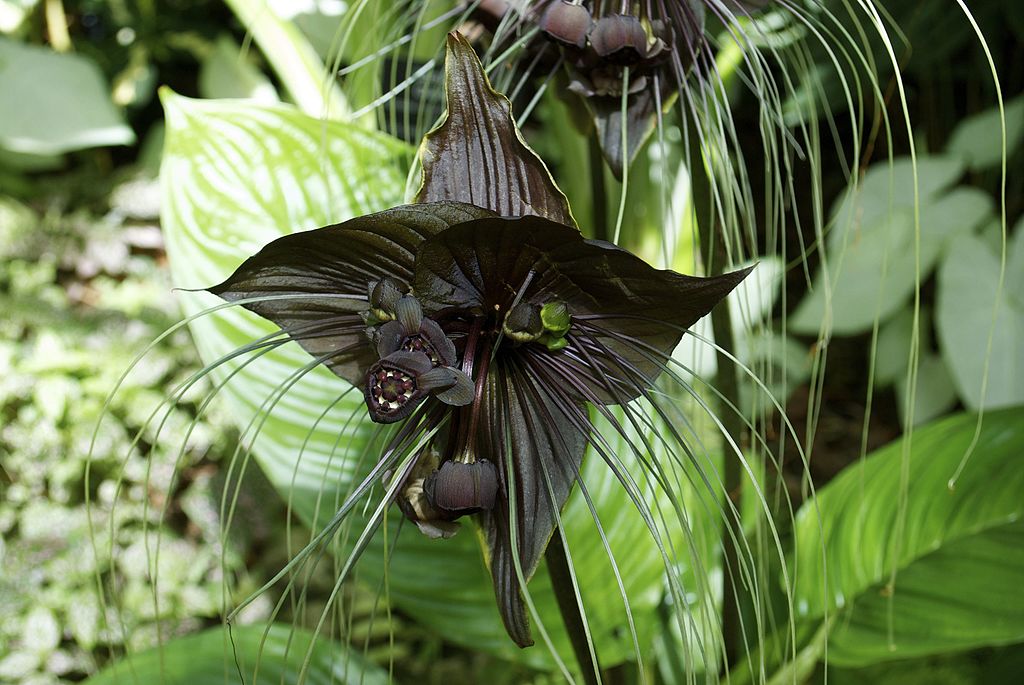| Membership | Price (+HST) |
|---|---|
| Single | $85/year |
| Single Plus | $120/year |
| Family | $130/year |
| Family Plus | $175/year |
| Contributing | $300/year |
| Supporting | $600/year |
| Sustaining | $1,000/year |
| Benefactor's Circle | $2,500/year |
| Director's Circle | $5,000/year |
| President's Circle | $10,000/year |
Supernatural Botany and Halloween
By Alex Henderson, Curator of Living Collections, Royal Botanical Gardens.
2020 has been the strangest year in most people’s living memories but as we approach the cusp of Halloween it’s about to get a whole lot weirder as the days get shorter, the nights get longer and we approach the witching hour of the spookiest day of the year. To get you in the mood lets take a fun look at 10 plants with names that are perfect for the spook fest!
Dracula orchids
The orchid genus Dracula, comprises 118 species native to Mexico, Central America, Colombia, Ecuador and Peru. The name Dracula refers to “little dragon”, which is a reference to the mythical Count Dracula, created by author Bram Stoker and whose fictional creation has become a major pop/horror culture character in numerous vampire novels, films and comics and games. The name was given to these orchids because of the blood-red color of several of the species. My favorite is the species Dracula vampira for obvious reasons!

Zombie Palm
Zombia antillarum, or zombie palm, is a species of palm tree which is the only representative of the genus Zombia. It is endemic to the island of Hispaniola in the Greater Antilles growing in the dry, hilly areas of northern and southern Haiti where it is threatened by habitat destruction. It is called zombie palm due to the spiny appearance of its trunk. The good news is that the leaves can be used to weave hats that may help to protect your “braaaaaaains” in the event of a zombocalypse!

Devil Maple
Acer diabolicum, or devil maple is native to central and southern Japan and is planted as an ornamental in that region where it will usually attain 7-9 metres (20 to 30 feet) tall with a rounded habit. It is not particularly well known in north America other than in botanical garden and arboreta plant collections as seeds from Acer diabolicum were sent to botanical gardens in Britain and the United States in the late 1800s and early 1900s. This maple gets its diabolical name from the two horn like structures which protrude from the flowers and are retained on the seeds.

Corpse Flower
Amorphophallus titanum or corpse flower is native to Sumatra and Borneo and is famous for having the largest inflorescence (a cluster of flowers arranged on a stem) of any known plant. When in flower the plant emits powerful odors to attract carrion pollinators which feed on dead animals or lay their eggs in rotting meat so hence the name corpse flower. The potency of the odor includes hints of onion, limburger cheese, garlic, rotting fish, mothballs, and feces. Mmmmm, happy Halloween!

Hemerocallis ‘Bela Lugosi’
Hemerocallis ‘Bela Lugosi’ is a beautiful variety of day lily, with deep purple flowers with a lime-green throat. Blooming early in the morning, it is extremely floriferous and easy to grow. This particular cultivar is named after Hungarian-American actor Bela Lugosi (1882-1956) famed for his portrayal of Dracula in the 1931 film of the same name and directed by Tod Browning and produced by Universal Pictures. He also appeared in many other horror films including Night of Terror, The Black Cat, Mark of the Vampire, The Raven and Son of Frankenstein all of which are great film choices for a spooky and socially distanced Halloween.

Ghost Plant
Monotropa uniflora or ghost plant derives its common name from its unique cadaveric white coloring. This is because ghost plant is a parasitic perennial and does not contain the green pigment chlorophyll. Instead of generating energy from sunlight it instead forms mutualistic relationships with certain fungi and mycorrhiza deriving energy from photosynthetic trees. To add to this plant phantasmal image, it can grow in very dark environments as it does not require sunlight giving it an even more ghost like appearance. So, if there’s something strange in your neighborhood, who you gonna call?
(This one grows in RBG’s Nature Sanctuaries!)

Bat Flower
Tacca chantieri or bat flower is a strange orchid with long thin strands that protrude from two ear like petals and other odd assortments of strange morphological features the sum of which looks a plant from a strange science fiction film or Stephen King novel. It also has a weird purple/black sheen to the flower that glistens and makes it look perfect as an addition for the floriferous favorites of Dracula’s castle but don’t let that drive you batty.

Devil’s Claw
Proboscidea louisianica, better known as devil’s claw, is an annual herb deriving its name from the fruit which are capsules up to 10cm long with a long narrow curving beak. As a fruit dries the beak splits into two distinct horns which can be up to 30cm in length and resemble large claws. These hooked fruits attach to the fetlocks of animals such as horses, cattle, pigs, and sheep which then spread the seed through their movements. Let us hope they don’t attach so easily to the infamous cloven hooves of he who walks backwards during a witch’s sabbat as it’s easy to get hooked on this plant.

Bloodroot
It would of course be remiss to end any Halloween celebration of creepy plant names without including an Ontario native. Sanguinaria canadensis, known as blood root, is an herbaceous perennial with white flowers with yellow centres that blooms from March to May. The name blood root derives from the colour of the sap which is red, and which is also responsible for the genus name Sanguinaria coming for the Latin sanguinarius meaning bloody. For good Halloween measure the sap is also poisonous and comprised primarily of the toxin sanguinarine which has the ability to kill animal cells so hey, if you are a zombie, no worries!
(This one grows in RBG’s Nature Sanctuaries!)

There are of course many other plants with Halloween connections such as garlic to ward of vampires, wolfsbane to protect from werewolves and hawthorn to guard against witch’s but the above 10 plants are some of the creepiest plant names for a supernatural Halloween full of botanical bedazzlement. Have a healthy and happy COVID-19 free Halloween and please follow the rules at ontario.ca
More from the RBG Blog
Check out RBG’s blog for announcements, articles, and more from Canada’s largest botanical garden.
Want to be sure you hear first? Sign up for our weekly e-newsletter to hear about upcoming events, weekend activities, articles, and more!












